On View
Why Artist Simon Fujiwara Rebuilt Anne Frank’s House Inside an Israeli Gallery
The heady artwork is actually a poignant critique of capitalism.
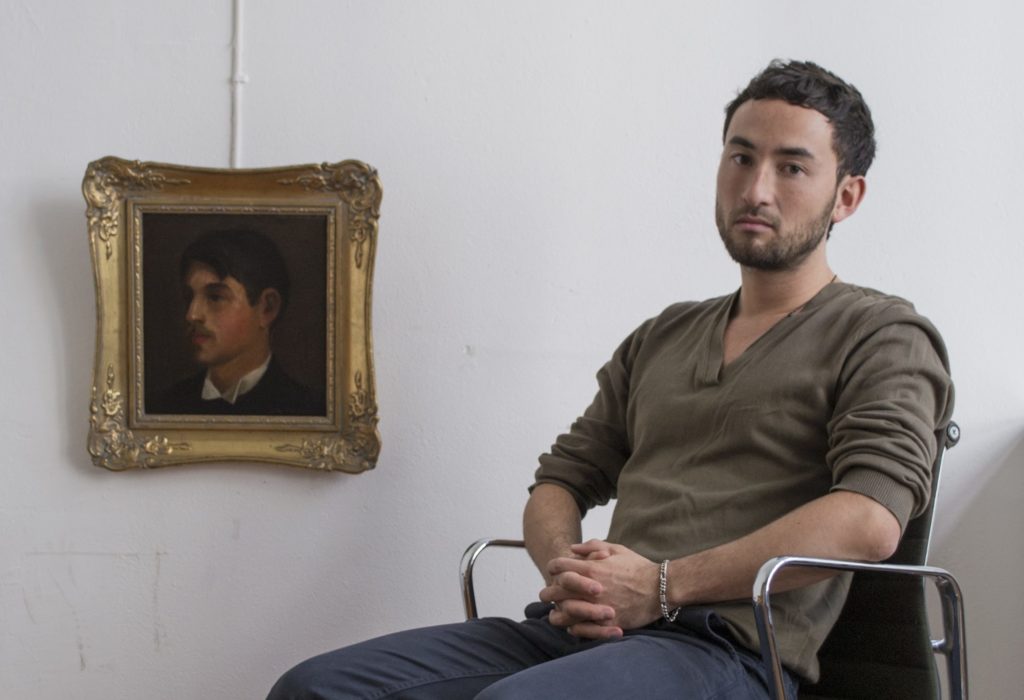
The heady artwork is actually a poignant critique of capitalism.

Hili Perlson

Artist Simon Fujiwara does not shy away from controversy—and his latest piece may be his most controversial yet. In Dvir Gallery in the south of Tel Aviv, Israel, Fujiwara is showing Hope House, a life-size reconstruction of the Anne Frank House in Amsterdam.
But the Berlin-based artist does not pursue provocation for its own sake. Quite the opposite, in fact: He sometimes finds the material for his ambitious works, which often blur fact and fiction, in public scandals and simplistic reactions to the complexities of the human condition.
His video piece Joanne (2016), for example, delves into the story of his former art teacher Joanne Salley, who resigned from Harrow School for Boys in London due to a sensationalist tabloid story blown out of proportion in 2011. Topless photographs of her, taken by a female photography teacher, were discovered by pupils on a hard drive, distributed around the school, and then sent to the yellow press.
With observations about incidents such as this, Fujiwara turns the mirror towards his viewers, urging them to contemplate the nature of their reactions. An astute maker of seductive environments, Fujiwara creates scenarios that physically lure his viewers into serious engagement with uneasy questions.
His new work is no different. The installation is based on a 3-D model of the Anne Frank House sold at the house’s gift shop. Not unlike a toy dollhouse, the model is cut down the middle so that both the exterior and interior are visible. Fujiwara blew up the model and put together the pieces of the puzzle inside the four-story gallery so that each floor of the building corresponds to one-and-a-half floors of the Anne Frank House.
Viewers are invited to walk around the exterior and enter individual rooms. Inside, a fully functional house awaits, complete with power outlets and furniture—as well as a slew of historically inaccurate items. And while these artifacts may at first confound viewers, they in fact hold the key to the artist’s canny message.
We caught up with Fujiwara ahead of the work’s debut to find out how—and why—he made it.
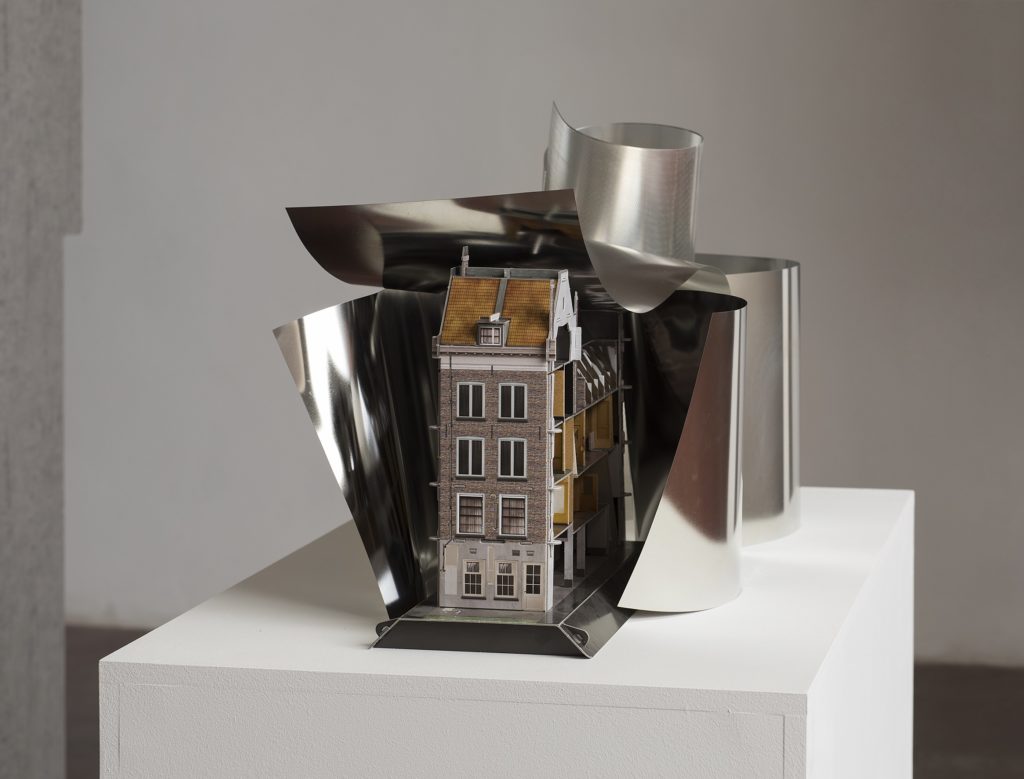
Simon Fujiwara, Hope House (2017). Exhibition view at Dvir Gallery, Tel Aviv, 2017. Photo Elad Sarig, courtesy the artist and Dvir Gallery.
The Anne Frank House isn’t a site that I would immediately associate with the issues you often deal with in your work. What made you want to do this project?
I never thought about working with this material and I never read the book growing up, but I was teaching in Amsterdam and wanted to take the students to see the house as we were discussing monuments and how ideology translates into material language. Like everyone, I had my own image of what the Anne Frank House is, what it would ask me to feel, and how it would make me behave, but I wanted the students to try and look at the house as objectively as possible, as sculpture.
The Anne Frank House has become something akin to a holy pilgrimage site; it is one of the few places where every mundane detail of a home—door handles, wallpaper, floorboards—transcend their material status and become symbols of tragedy and hope. There is a three-hour queue outside the house each day and I came to understand that, like all experiences on this level of populist appeal, the house offers the visitors a very clear product-experience. The completeness of the Anne Frank narrative, how it ties into the clear-cut narrative of WWII, good and evil, hope and tragedy, are extremely appealing on a mass scale due to the sense of clarity and simplicity it offers consumer-visitors. In this sense I started to think of the house as a kind of readymade—not a house that is lived in and evolves, but a time capsule, untouchable.
Can you describe your first-ever visit?
Inside the house, I was told by the guide that almost nothing of the original house remains except for the structure. That the house was only purchased after the making of the first Hollywood film about Anne Frank and that it had since undergone several renovations to make it look as authentic as possible. I asked about the wallpaper in the room we were in, which looked very clean but was obviously not of our time, and I was told that it came from Germany and was produced under the GDR [German Democratic Republic]. It was chosen for its color and texture matching.
I thought, “What are the ethics of having communist German wallpaper lining the Anne Frank House?” I found it extremely exciting to encounter this pragmatism in a house that is so clearly ideological. Discovering that the house’s interiors and atmosphere were not “authentic” but were largely staged only made the house more interesting and beautiful to me because they spoke of a human truth: the nature of our pragmatism. That felt more authentic than a pure narrative of hope. That was the message I took from the house.
How did you end up with the model of the house?
By the time I got to the gift shop I was very moved and excited and bought almost everything they had, including the model of the building. Sometime later I began constructing the model and couldn’t get my head around the product. It was so beguiling. I felt uncomfortable having such control over its construction, but I also felt invited to participate, almost as if the process of making the model house offered permission to make it my own.
The fact that the museum makes a product of the house might make some people uncomfortable—even if all proceeds go to their charity—but for me it was a perfect snapshot of the times we live in. The dominant ideology that we have created today is capitalism, and nothing can escape it—you participate or die. The foundation must know that, in order for the story of Anne Frank and its message to survive in the 21st century, it also needs to offer a product and the sense of participation. It made me marvel at the power and agility of capitalism to really consume everything, but also the truly equalizing, democratic fact that before marketing, we all stand naked and defenseless. Even Anne Frank.
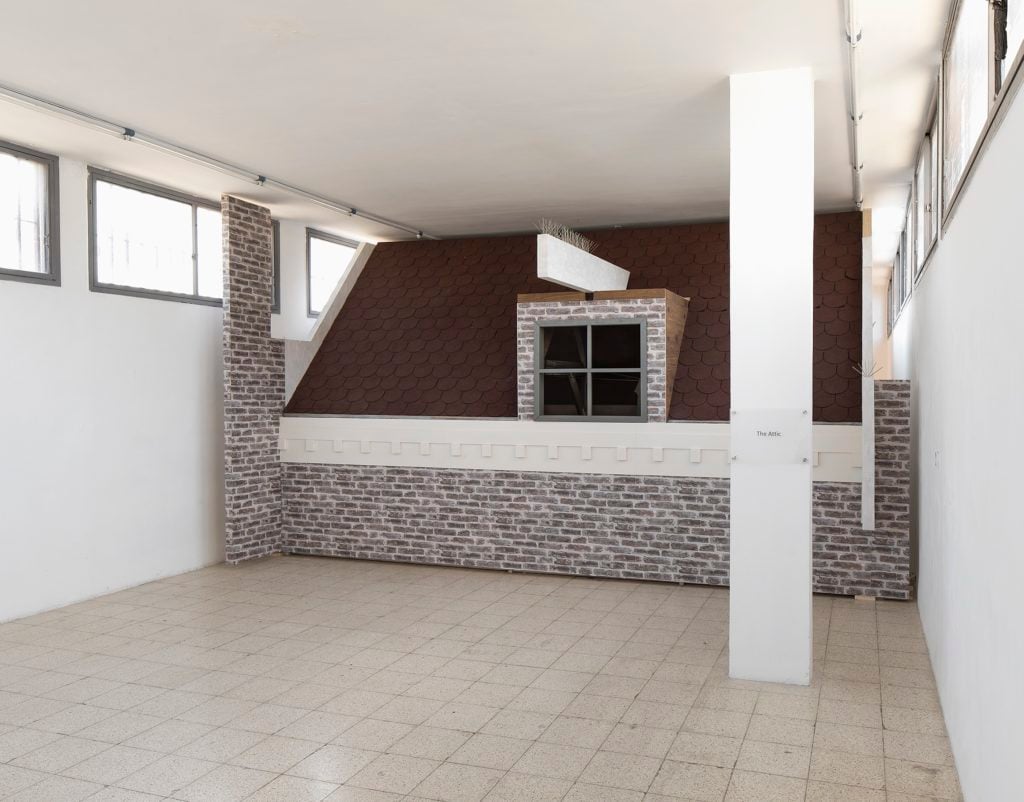
Simon Fujiwara, Hope House (2017). Exhibition view at Dvir Gallery, Tel Aviv, 2017. Photo Elad Sarig, courtesy the artist and Dvir Gallery.
Did you at any point of the process involve the Anne Frank House directly or inform them that you would be doing this?
No. I made a conscious decision not to contact the house or foundation for the simple reason that I didn’t want to enter a relationship with them. I knew that once I spoke to a human, got to understand their objections or their support for my project, it would begin to work on me and affect what I wanted to say, which is not really about the Anne Frank house at all. I read the basics about the history of the house, the diary publication, etc. But I am not an artist who is interested in research. I know how much I need to know to make a work—the rest is all feeling, listening, and craft.
In this work, then, are you criticizing the way in which the Anne Frank House actively participates in these processes? Are you asking if it’s OK for them to engage in this kind of branding and sell merchandise?
No, I am not criticizing the house or the foundation. I don’t have a personal, one-line take on what they are doing, but I try to approach it with openness. I’m looking at it from a historical perspective, saying to myself, “This is happening today. Why?” I’m trying to understand the decisions made by the people who are behind products like the model. It’s not a judgment; I am driven by curiosity. I wonder if the foundation, producers, and designers of the model had doubts or concerns about what they were doing and how they justified it or narrated it to themselves. And when I imagine those discussions, they mirror what I think a lot of people are questioning within themselves today, or at least I am.
Like the Anne Frank House, we as individuals today are asked to market ourselves, to present ourselves increasingly simplistically, as products, and to utilize what may once have felt sacred and personal to move ourselves forward. Can I be a brand and still be a human? Where is the line drawn? I believe this is one of the dominant concerns that we’re going to be facing as individuals this century.
Although this question has existed in some form since time immemorial, technology has changed everything and there is no way back. I’m disturbed and excited about it. I want to understand and record it, which is the privilege of being an artist and living in this age.
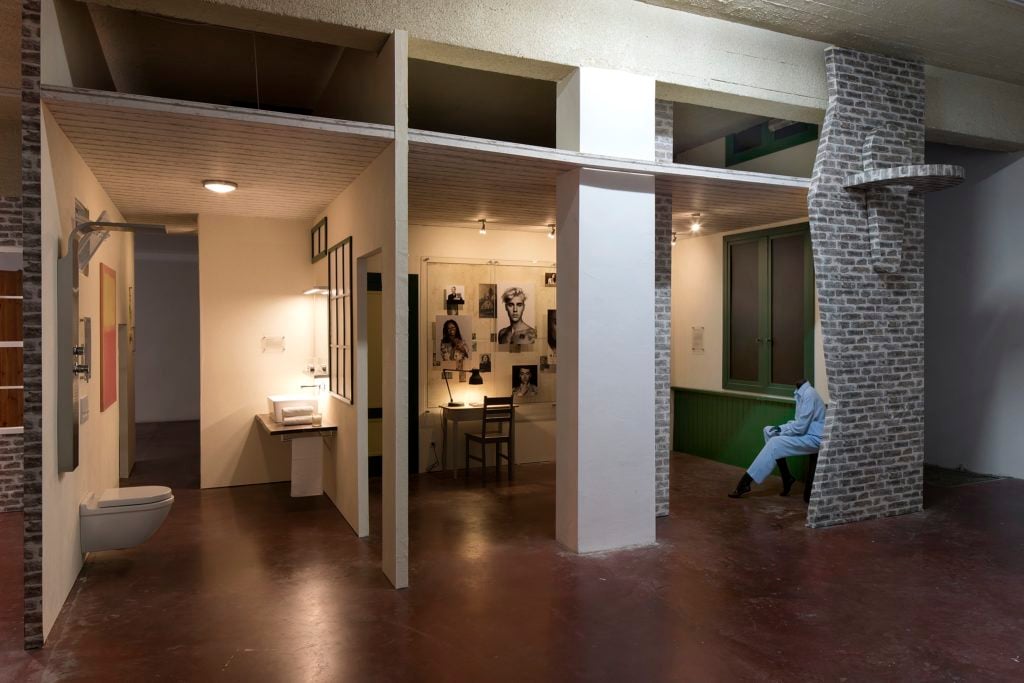
Simon Fujiwara, Hope House (2017). Exhibition view at Dvir Gallery, Tel Aviv, 2017. Photo Elad Sarig, courtesy the artist and Dvir Gallery.
Speaking of branding, celebrities visiting the Anne Frank House, or other symbolic places and memorials, is something of a social media trope now. But it’s a risky one—sometimes it can go very wrong. I’m thinking of the Justin Bieber scandal.
Bieber visited before his concert in Amsterdam and wrote in the guestbook, “She was a great girl. Hopefully she would have been a belieber” (as in, one of his fans). It caused a huge social media storm. People were outraged by his personalization of the Anne Frank experience. It doesn’t offend me because I don’t expect pop stars to act humbly or selflessly since what we celebrate in them is largely their self-absorption. However, I found it interesting that so many people were ready to take offense on behalf of someone they have no relation to in a place they may not have even visited themselves.
The most important aspect of the story is the fact that the Anne Frank House posted the Bieber guestbook entry on their own official Facebook page first, and in this respect were approving his comments. I don’t have a position on whether they were right or wrong to do this. Their motives are clear—it attracts more attention, from a young audience, to a cause they want to promote.
Interestingly, the House is often seen as a litmus test of celebrities’ “humanity.” When celebrities post images of themselves visiting the Anne Frank House, they are in part sending a message that they are humble, human, and, in the face of great historical events, also equal to us.
Bieber is a white, entitled rich male and is on the other end of the ideological spectrum from Beyoncé (black, female), whose visit to the house was largely celebrated. Beyoncé, who is extremely studied and in control of her image, understands that you don’t wear Givenchy when you go to the Anne Frank House. She wore a sky-blue casual trouser suit by Topshop. She took tasteful photos in the areas where you’re allowed to, and posted pictures of herself crouching low under images of Anne Frank.
Within 40 minutes of her Instagram post, the Topshop outfit was sold out internationally.
One of the first items I wanted to show in Hope House, my reconstruction of the house, was this outfit, but as it was no longer possible to buy it. I had to have it hand tailored with fabric that I personally sourced in Italy. This was the first of many documents, objects, and products that I began producing or sourcing to fill Hope House. I wanted the house I created to present the perversity, complexity, and contradiction of the world we live in today, where every object we own contains an ideology, every shred of material is a product. I wanted it to speak about how controlled we are by the ideology of capitalism—and how much we enjoy it, desire it, even if we know deep down something is wrong.
You’ve chosen to debut the work at your gallery in Israel, where the language around the memory and singularity of the Holocaust is inseparable from national identity. In using the house as a framework for a critique of capitalism, aren’t you worried you might be asking too much of your viewers?
No, I’m not worried. I’m confident that people who experience the work will be able to interpret it because I’m confident in my ability as an artist to translate what I want to say into material. I believe that experiencing my artwork is not only an intellectual experience but a physical one, and since we all have bodies and share a similar biology, then everyone can get something from the experience, whatever your education. That is why I am so obsessively focused on the sculptural, physical experience of my work.
If you ask me about the reception of the work by people who haven’t experienced it, then, yes, I have concerns. In the process of making the work I asked several people what they thought about this proposition of bringing an updated version of the Anne Frank House to Israel, because on the most basic level that is how one could describe the project. Almost all Europeans and Americans reacted with discomfort, and many questioned my motives. When pushed as to why they felt this, many said they were worried that Israelis would be offended by the work. But every Israeli I spoke to in the lead-up to the show said, “This is something I want to see.” They were curious.
It confirmed to me that humans are much better at making quick judgments and being offended on behalf of others. From an outside perspective, the Israelis were cast in a narrative of the victim, which is tied up with the Holocaust narrative, and this work was seen as distasteful. The Israelis I spoke to clearly didn’t think of themselves within this victim narrative, didn’t see this as a threat, and therefore didn’t feel the need to defend or protect themselves. It’s interesting that one of the very ideas at the root of Hope House was to question this very impulse we have to judge from a distance. It confirmed to me the importance of making this work.
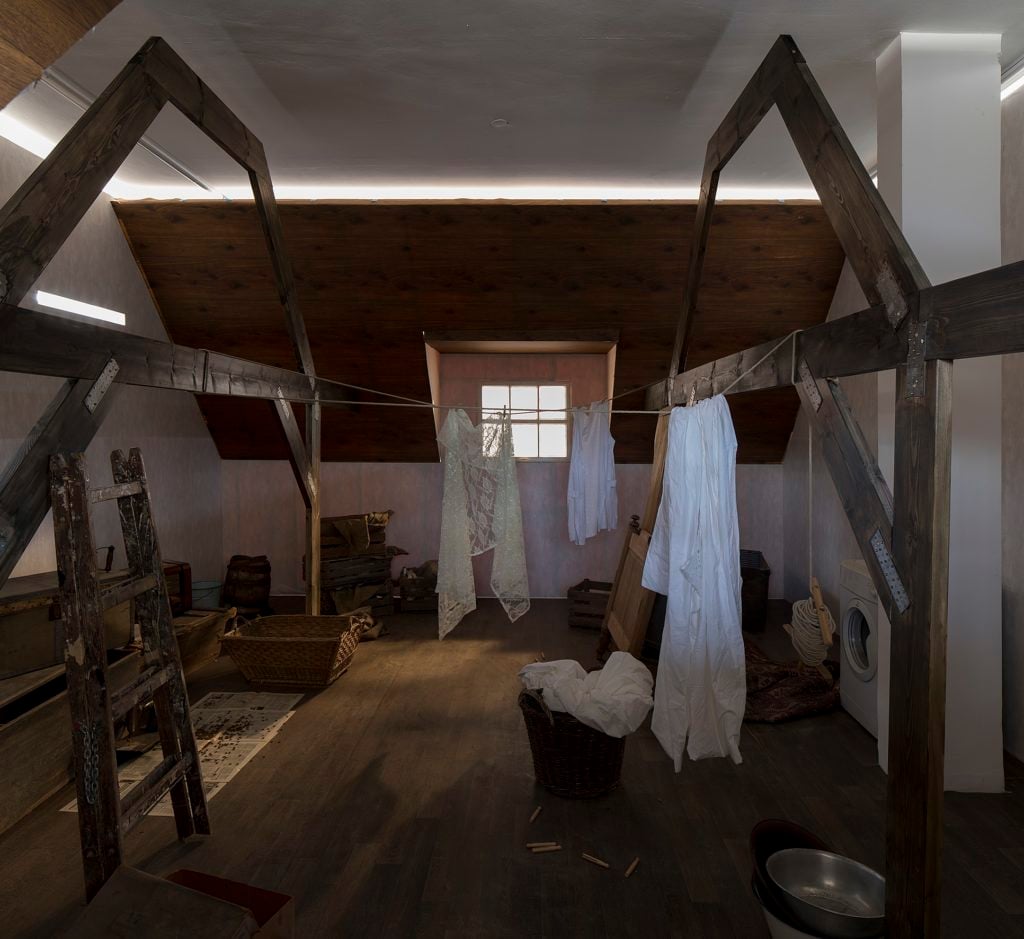
Simon Fujiwara, Hope House (2017). Exhibition view at Dvir Gallery, Tel Aviv, 2017. Photo Elad Sarig, courtesy the artist and Dvir Gallery.
Have you had any doubts along the process of working on this piece, or any concerns about this work being attacked by someone in the way you’ve just described—being offended in someone else’s name?
A couple of months into working on this project I started to panic, as it dawned on me the enormity and complexity of the subject. I was also confronting how important it was to me to confront the increasingly ideological world we live in and its stifling of questioning and curiosity. I knew that by making the work I could be seen as arrogant, entitled, insensitive, etc. Regardless of how good or complex the artwork might be, if the wrong photos and text from the exhibition were to go viral, it could be totally misunderstood.
It was presented to me as a risk by everyone around me, and although the people who care about me personally agreed that my approach to the project was not actually inflammatory or controversial, the world today might not see it that way. I sweated. But in my gut, I knew the work needed to be made and the fact that the internet-fueled world of public opinion might be extremely simplistic was not a reason for me or my work to become simplified.
If art cannot master, alter, expand the environment it exists in, the environment will control and consume us all. Although the work is not about the person Anne Frank, ironically, this is the message I took from reading her diary.
What would you do if this backfired—if indeed, an Instagram post, or even this interview, gets misinterpreted?
It’s difficult to say as it hasn’t happened, but it’s definitely not something I want. I am not looking for controversy. The reason I was drawn to art and the art world in the first place was because it is not about sensationalism at its core. It operates over a longer time, over centuries in some cases, and sensation is momentary and fixed to historical context. I think on a level it’s noble that people argue against the elitism of art, but I also wonder if this comforting narrative of all art being able to be understood and accessed by all people is yet another capitalist-fed, pseudo-democratic ideology that subdues our anxieties about the increasing polarization and divisions in the world.
They say that you need an education to appreciate art, but I feel like I discovered art through curiosity. Nobody in my family introduced me to art and I don’t come from wealth. It has taken me years to be able to talk about art and to understand its effect on me. I think I was drawn to it for this reason: its complexity and the slow, elastic time frame in which it operates. So, to answer your question, even if the mainstream media or the internet decides to make a shit storm about this work, I know there will be viewers who will confront it on their own terms. The beauty of art is that it creates a space where everybody is actively seeking contradiction and consensus simultaneously, which in itself is a contradiction. That’s what I fell in love with, and it’s what I fight for.
“Origin Story” is a column in which we examine the backstory of an individual work of art.
“Simon Fujiwara, Hope House” is on view at Dvir Gallery, Reshit Hochma st. 14
Tel Aviv, 6135302, Israel from September 2–October 21.